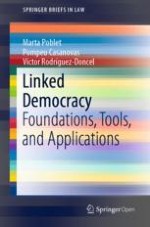Communication technologies have permeated almost every aspect of modern life, shaping a densely connected society where information flows follow complex patterns on a worldwide scale. The World Wide Web created a global space of information, with its network of documents linked through hyperlinks. And a new network is woven, the Web of Data, with linked machine-readable data resources that enable new forms of computation and more solidly grounded knowledge.
Parliamentary debates, legislation, information on political parties or political programs are starting to be offered as linked data in rhizomatic structures, creating new opportunities for electronic government, electronic democracy or political deliberation. Nobody could foresee that individuals, corporations and government institutions alike would participate in a joint space of information establishing mutually beneficial relationships.
Chapter
1 has presented in detail the technologies enabling the Web of Data and has sketched practices of much interest for experts in political studies. The concept of democracy, which has remained relatively unaffected by this wave of changes, needs a revision and the idea of a Linked Democracy is an exploratory contribution.
Chapter
2 has reviewed deliberative and epistemic models of democracy and traced how some of their features are present in the current ecosystem of civic technologies. Building on both these models and empirical examples of participatory ecosystems we propose the concept of Linked Democracy as a basis to represent distributed, technology-supported, collective decision-making processes where data, information, and knowledge are connected and shared by citizens. Chapters
3 and
4 expand this concept by sketching a multilayered model and preliminary suggesting some core properties that we connect with Ostrom’s design principles for the effective management of common-pool resources.
Chapter
5, finally, outlines the regulatory frameworks for linked democracy ecosystems that we denominate ‘socio-legal ecosystems’ and, on top of them, the concept of ‘meta-rule of law’. The chapter distinguishes between hard law, governance, soft law and ethics. They are connected and constitute what we have called the “legal quadrant” for the rule of law.
The Web of Data is any data available on the web in any form, such as raw data files, data exposed via API, or IoT streams. Linked data is a subset of the former set, i.e. it is an approach to publishing and sharing data on the web, following the five rules proposed by Tim Berners-Lee. We have contended that the protections and principles of the substantive rule of law can be represented into the languages of the Web of Data and embedded into compliance systems to generate trust and to define the global space as a public space.
The notion of linked democracy operates within this space in which corporations, companies, rulers, providers, consumers and citizens are using all kinds of linked-data repositories that cannot be treated as separate silos, as they are (or will be) linked through graph-driven mechanisms. The notion of relational law points at the allocation of behavioural expectations (assignment of rights and obligations) in terms of a shared technological framework in which computer systems and human-machine interfaces create an aggregated value fostering the connection between Web 2.0 and Web 3.0. Our goal has been to provide a conceptual roadmap that helps us to ground the theoretical foundations for a meso-level, institutional theory of democracy.
The Web of Data has transformed the way we access, produce, share, and reuse information, data, and knowledge. Most likely, further developments will come in successive waves of innovations in distributed technologies, machine learning, image and voice recognition, etc. These technologies will shape in new ways how we behave, interact, and make decisions as individuals, groups, and crowds. But as citizens of free societies we should retain our say in these processes. In the digital era, this can be done by augmenting, enriching, and diversifying the ways to participate and align our decisions. This book has started to explore this path.
Open Access This chapter is licensed under the terms of the Creative Commons Attribution 4.0 International License (http://creativecommons.org/licenses/by/4.0/), which permits use, sharing, adaptation, distribution and reproduction in any medium or format, as long as you give appropriate credit to the original author(s) and the source, provide a link to the Creative Commons license and indicate if changes were made.
The images or other third party material in this chapter are included in the chapter's Creative Commons license, unless indicated otherwise in a credit line to the material. If material is not included in the chapter's Creative Commons license and your intended use is not permitted by statutory regulation or exceeds the permitted use, you will need to obtain permission directly from the copyright holder.
